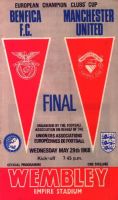| Manchester United Club Profile - Memorabilia
|  |
Visit the new Manchester United museum and you'll get some idea of just how much football- related memorabilia there is. From old programmes to players' jerseys, football cigarette cards to cup winners' medals, there are all sorts of items that have played their part, however small, in the proud history of United. The museum, the first of its kind in England, was opened in 1986. In its first year, 25,000 people passed through its doors. In 1997, 192,000 people from all over the world visited the museum. It had become so successful that it had outgrown its original site so it was relocated to
three floors in Old Trafford's huge North Stand. The new museum opened in spring 1998. It is the definitive history of Manchester United, and has some unique memorabilia on display.
When people think of football memorabilia they usually picture a box of old programmes gathering dust and, for most supporters, programmes are the most accessible items of memorabilia. Collecting programmes has become so popular that some people make a living out of their hobby. It might be worth wiping the dust off any old programmes you own; you could have a rare example worth thousands of pounds.

In 1997, a programme from Manchester United's postponed game against Wolverhampton Wanderers at Old Trafford in February 1958 was sold for £1,925. That price surpassed the £1,887 paid for a programme from United's 1958 game against Red Star Belgrade. The reason that these programmes fetched such high prices was because of their relevance to the Munich air disaster. United's game in Belgrade was the last time that the Busby Babes played together on a football field, and with so few United fans making the journey, practically no programmes came back to England. It's that scarcity that makes the price so high.

The image of a United player shaking hands with a supporter, a design that has  remained almost unchanged for years, gives the United Review one of the most distinctive mastheads of any British programme. It even has a collectors' club, with 250 members. Perhaps the most famous United Review is the one from the first post-Munich match, an FA Cup tie against Sheffield Wednesday. Under the heading "United Will Go On" the Review outlines what happened at Munich. The United team line-up was left blank because it wasn't known who would play until the last minute. Copies are only worth about £30 because 60,000 were printed, so there are plenty to satisfy the demand. In terms of sentiment, though, they're priceless.
While collecting programmes is the most popular method of accumulating football memorabilia, there has been a surge of interest in other items in the 1990s, influenced partly by the American obsession with sports memorabilia.

Medals always create a lot of interest, especially when they happen to be a European Cup winners' medal and a World Cup winners' medal, the two most prestigious medals that a player can win. In England, only Bobby Charlton and Nobby Stiles share the distinction of owning both medals.

Up until the early 1990s it was possible to gain admittance to Old Trafford by paying cash at the turnstiles. A huge increase in the demand for tickets, at both home and away games, coupled with shrinking ground capacities, meant that supporters needed to buy a ticket in
advance for practically every single Manchester United game. Tickets for Cup Finals and big European games are always scarce and change hands for vastly inflated fees on the black market. Old and rare tickets, like programmes, are highly prized, especially if they also have sentimental value. These days, to avoid counterfeiting, tickets have holograms and watermarks.

The kit that a certain player wore in an important match or League championship medal can be worth tens of thousands of pounds.  A shirt worn by Eric Cantona in his last game for United was sold for £2,000 and the boots that Bryan Robson wore in his final game for Middlesbrough were auctioned for charity and raised £1,500.
The most intriguing pieces are usually one-offs, such as the telegram Duncan Edwards sent to his landlady telling her he would be home late from Munich.

Flags have been popular at United games for years, especially on a European away trip. Arguably the finest display of United flags was seen at Rotterdam for the 1991 Cup Winners' Cup Final when 25,000 United supporters went to Holland to watch United beat Barcelona 2-1.


Some items are unlikely to find favour in the future. A 1970s United supporters white butcher's coat covered in United badges will probably not accrue value with time, and the wooden rattle is unlikely to make a comeback.
The 1990s has seen the large clubs, including United, greatly expand their merchandise departments, and today you can buy practically anything with the United badge on, from duvets to desk lamps. Your green and gold third kit from 1993 might be lucky to see the light of day today but it's worth keeping hold of, since it might come back into fashion as "retro wear" one day.

© Patrick Eustace 2000. Page maintained by Patrick Eustace, last updated Sunday, 16-Jan-2000 19:59:46
| |
|



